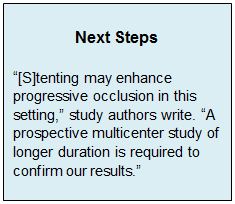Key Points:
- Single-center study looks at use of stenting in small unruptured aneurysms after coiling
- Greater 6-month progressive occlusion rates with vs without stents
Stenting may lead to better occlusion of small unruptured intracranial aneurysms that have residual sac filling after coiling, according to a small propensity-matched analysis of retrospective, observational data. The findings were published online October 27, 2015, ahead of print in the Journal of Neurointerventional Surgery.
Young Dae Cho, MD, of Seoul National University Hospital (Seoul, Korea), and colleagues explored the outcomes of patients (mean age 58.4 years; 69.5% women) with 715 small unruptured intracranial aneurysms that were treated with coiling between 2008 and 2010.
Immediately after coiling, 28.8% of the unruptured aneurysms showed residual filling of contrast-filled sacs on angiography, as stipulated by the Raymond scale. Multivariate analysis revealed that female sex (P = .02), advanced age (P = .01), smaller lesion size (P < .01), non-branching vessels (P < .01), and wide necked aneurysms (depth-to-neck ratio ≤ 1; P = .01) were all linked with contrast retention immediately postembolization.
Of the lesions with residual filling, 72 were stented and 134 were not. The investigators compared rates of progressive occlusion in the stented and non-stented lesions directly and using propensity-score matched analysis.
At 6 months, 88.3% of the lesions with residual filling displayed progressive occlusion, defined as complete occlusion of the contrast-filled sac. Aneurysm size, neck size, and embolization attempt all differed between stented and non-stented lesions (P < .01 for all). However, the incidence of progressive occlusion did not differ between the groups (87.5% vs 88.8%, P = .78).
Among matched pairs, the rate of complete occlusion was greater in stented compared with non-stented lesions at 97.5% vs 80% (OR 9.75; 95% CI 1.16 to 82.11).
Reaching Toward Goal of Complete Occlusion
“Incompletely occluded endovascularly treated saccular aneurysms are subject to recanalization and recurrent hemorrhage over time,” the authors write. “Hence the aim of every neurointerventionalist is complete occlusion.”
Yet a recent systemic review reported an 8.8% rate of incomplete occlusion after coil embolization, they point out. To improve the situation “[s]tents have been used to increase packing density during coiling and alter hemodynamics (ie, flow diversion and endothelization of aneurysm neck).”
In this series, the benefit of stenting “was conferred despite a significant disparity in antiplatelet maintenance therapy of stented (40/40, 100%) and non-stented (14/40, 35%) subsets (P < 0.01),” Dae Cho and colleagues note.
They conclude that “stenting may enhance progressive occlusion in this setting. A prospective multicenter study of longer duration is required to confirm our results.”
Source:
Jeon JP, Cho YD, Rhim JK, et al. Effect of stenting on progressive occlusion of small unruptured saccular intracranial aneurysms with residual sac immediately after coil embolization: a propensity score analysis. J Neurointerv Surg. 2015;Epub ahead of print.
Disclosures:
- Dae Cho reports no relevant conflicts of interest.
